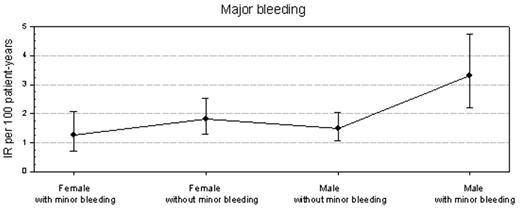Abstract
Easy bruising is frequently found in healthy women. This mild bleeding tendency may be enhanced by treatment with vitamin K antagonists. This may result in more intense monitoring of the level of anticoagulation (INR) to improve the individual time within target range (ITTR) and consequently to reduce the risk of major bleeding. We performed a retrospective study in 6758 consecutive patients receiving vitamin K antagonists for primary or secondary prophylaxis of venous or arterial thrombosis (mean age 67, 51% male and 189762 INRs in 6681 person-years) to evaluate differences in gender on the occurrence of minor and major bleeding, as well as the ITTR.
The incidence rates (IR, per 100 person-years) of minor and major bleeding were assessed and survival analysis performed to obtain adjusted hazard ratios (HR, 95%CI) for major bleeding in men versus women with or without prior minor bleeding, controlling for significant patient characteristics. Minor bleeding occurred more frequently in women than men (IR=33.2 versus 21.1, respectively; HR=1.5, 95%CI 1.4–1.7, p<0.001), whereas major bleeding showed a tendency towards a higher incidence in men (IR=1.6 versus 2.0; HR=1.3, 95%CI 0.9–1.8, p=0.20).
However, in women with prior minor bleeding, the incidence of major bleeding was low (IR=1.3, 95% CI 0.7–2.1), when compared to men with minor bleeding (3.3, 95%C 2.2–4.7) (HR =2.7, 95% CI 1.4–5.0, p=0.002). Men and women without prior minor bleeding had comparable incidences of major bleeding (IR 1.8, 95% CI 1.3–2.5, and 1.5, 95% CI 1.1–2.1, respectively), but both were higher than in women with prior minor bleeding (HR 1.4 (0.8–2.5, p=0.30 and 1.2 (0.7–2.2, p=0.55)). These differences were even more pronounced in patients at high risk of major bleeding due to a strongly reduced ITTR (ITTR below 30%, lowest quartile).
Considering the actually achieved level of anticoagulation, there were no differences between men and women with or without prior minor bleeding that could explain the reduced risk of major bleeding in women with prior minor bleeding. With 42% to 43%, the ITTR was comparable, as was the time spend above INR 5.0 (6% to 7%).
In conclusion, more frequent minor bleeding in women was associated with a reduced incidence of major bleeding, whereas in men, such a reversed association was not present. Differences in intensity of INR monitoring in patients with or without minor bleeding and as a result in actual level of anticoagulation, could not be demonstrated.
Disclosure: No relevant conflicts of interest to declare.
Author notes
Corresponding author


This feature is available to Subscribers Only
Sign In or Create an Account Close Modal